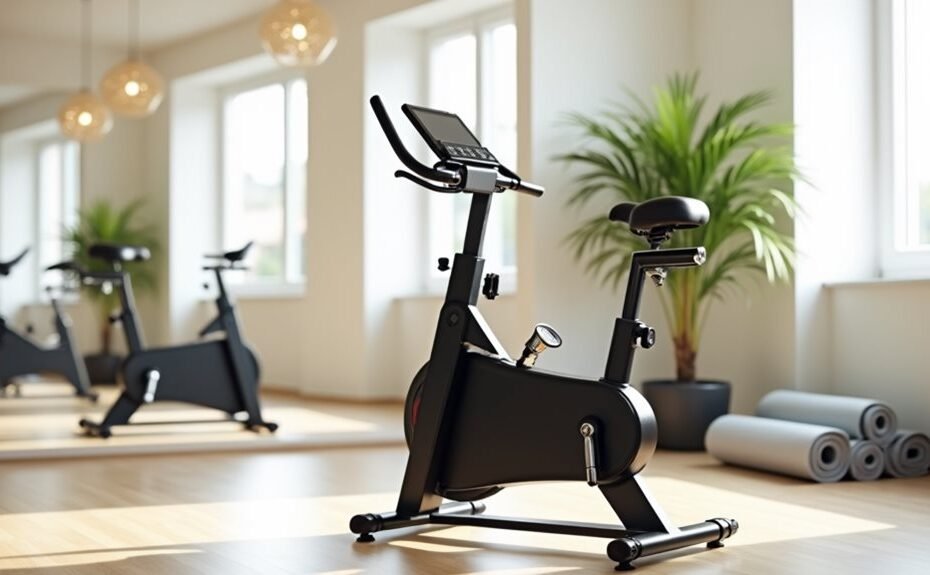I’ve spent years testing and reviewing exercise equipment, and I can tell you that upright bikes offer some of the most practical benefits in home fitness. While treadmills and ellipticals often steal the spotlight, upright bikes deserve closer attention for their space efficiency, joint-friendly workouts, and impressive calorie-burning potential. Whether you’re a beginner looking to start your fitness journey or an experienced athlete seeking low-impact training options, there’s more to these machines than meets the eye. Let me share what makes upright bikes a standout choice for your home gym.
Key Takeaways
- Upright bikes mimic natural road cycling position with swept-back handlebars and under-body pedal placement for maximum comfort.
- Full-body workouts target major muscle groups including quadriceps, hamstrings, glutes, and core while burning 500-700 calories per hour.
- Digital resistance systems and touchscreen consoles allow customizable training with threshold programs, intervals, and heart rate monitoring.
- Compact design requires minimal space, typically 22-25.5 inches wide and 32-48.25 inches long.
- Professional-grade features like WattRate power meters enable precise training progression and performance tracking.
What Are Upright Bikes
Picture a bike that puts you in a natural, relaxed position – that’s an upright bike. I’ll tell you exactly what makes these bikes special: they’re designed to mirror traditional road bicycles, but with comfort as the priority. You’ll find the pedals positioned right under your body and handlebars swept back for easy reaching. These bikes are perfect for daily transportation needs in urban settings.
Think of it as your body’s best friend in the cycling world. I’m talking about a design that supports proper posture while giving you a full-body workout. You’ll find these bikes in two main flavors: outdoor models (like those stylish Dutch city bikes) and stationary versions for indoor training. These bikes are excellent for fitness since they provide a higher calorie burn compared to other exercise equipment.
I’ve seen countless riders benefit from the upright design’s versatility. When you’re on one, you’re engaging your core, back, and leg muscles while maintaining natural balance. It’s remarkably similar to riding a regular bike, but with enhanced comfort and accessibility.
Trust me, whether you’re commuting through city streets or crushing a cardio session at home, an upright bike delivers precisely what you need – efficient exercise without unnecessary strain.
Space Requirements And Design
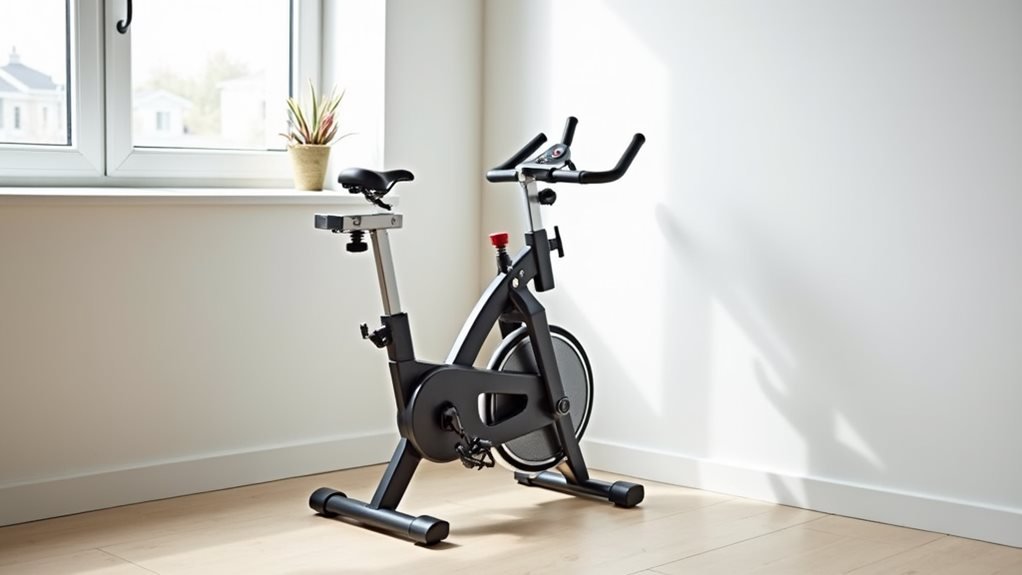
Getting the right space for your upright bike means understanding both its footprint and clearance needs. I’ll tell you straight up – these machines typically need between 22-25.5 inches in width and 32-48.25 inches in length, but that’s just the starting point. You’ll need additional clearance for safe operation, and I won’t sugar-coat it – skimping on space is a rookie mistake.
Standard vertical bike parking requires a minimum width of 500mm per bike when properly installed. A bike rack setback of at least 24 inches from any wall is recommended for optimal access.
Here’s what you absolutely must consider for proper bike placement:
- Minimum clearance of 1-2 feet on all sides (some models demand more)
- Transport wheels for mobility, though heavier bikes need two people
- Storage dimensions that account for protruding handlebars
- Floor space that allows easy access without cramping your workout
I’ve seen too many people jam their bikes into tight corners, only to realize they can’t properly mount or dismount. Trust me – measure twice, place once. The bike’s weight distribution, centered around the flywheel, helps with mobility, but you’ll still need a clear path for moving it. Remember, proper spacing isn’t just about comfort – it’s about safety and getting the most from your investment.
Primary Muscle Groups Targeted

The muscle-building benefits of upright bikes extend far beyond simple leg strength. I’ll tell you exactly what’s happening when you’re crushing those pedal strokes. Your quadriceps are the powerhouse, dominating the downward push, while your hamstrings kick in from the six to nine o’clock position. Your glutes? They’re working overtime for power and stability.
The spinal column and back remain highly engaged during an upright bike workout. Consistent cycling helps develop slow twitch fibers for enhanced endurance capacity. Don’t forget what’s happening above your legs. Your core muscles are constantly engaged to keep you balanced – that’s something you won’t get on a recumbent bike.
Your shoulders and triceps are bearing your upper body weight, while your forearms grip those handlebars like they mean it. Even your chest and upper back get in on the action to maintain proper posture.
Here’s the kicker: the intensity of your workout directly impacts muscle engagement. Crank up the resistance, and you’ll fire up those quads and hamstrings even more. Pick up the pace, and your hamstrings will really feel it. And when you’re tackling technical terrain? Your upper body muscles snap to attention for extra stabilization. It’s a full-body affair, whether you realize it or not.
Burning Calories While Biking
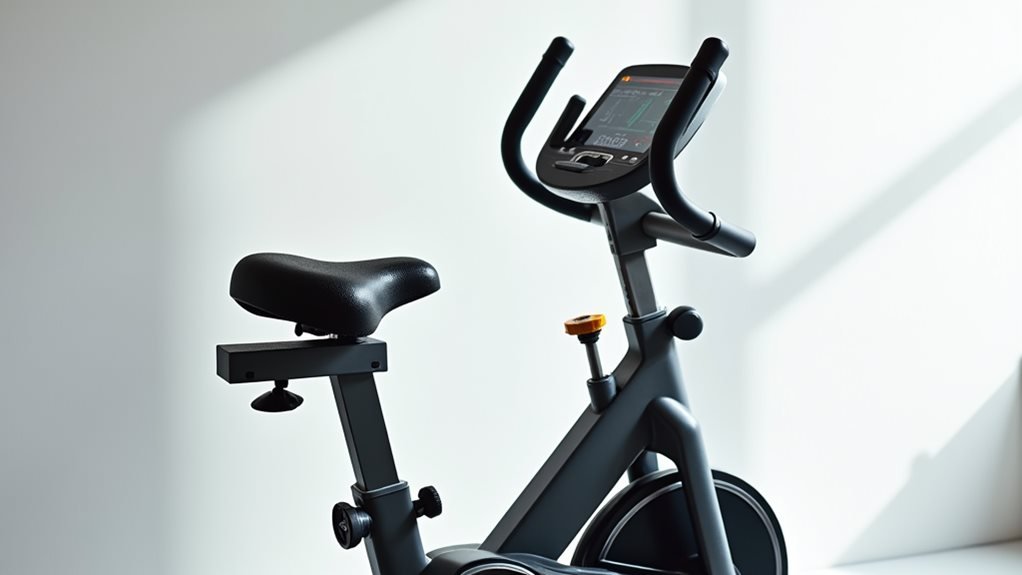
Every pedal stroke on an upright bike burns serious calories, and I’ll break down exactly what you can expect. At moderate intensity, you’ll torch between 500-700 calories per hour if you’re around 145 pounds. Standing up on your bike will engage more total-body muscles. Here’s what I want you to know: heavier riders burn more calories, and cranking up the intensity dramatically increases your burn rate. The outdoor cycling experience will naturally burn more calories compared to stationary bikes.
Let me hit you with the key factors that’ll maximize your calorie burn:
- High-intensity intervals will torch more calories than steady-state cardio – we’re talking up to 614 calories in just 30 minutes
- Upright bikes burn more calories than recumbent bikes because you’re engaging more upper body muscles
- Longer sessions at higher resistance levels create a bigger caloric deficit
- Adding HIIT workouts supercharges your post-exercise calorie burn
I’ll be straight with you – while upright bikes won’t match running’s calorie burn (nothing really does), they’ll smoke walking and most low-intensity cardio options. Plus, you’re getting a low-impact workout that’s easier on your joints. When combined with proper nutrition, you’re looking at a serious tool for weight management and cardiovascular fitness.
Getting Started With Upright Bikes
Starting your journey with an upright bike couldn’t be simpler, thanks to its intuitive design that mimics traditional cycling. I’ll tell you right now – if you’ve ever ridden a bicycle, you’re already halfway there. Just hop on, grab the handlebars, and start pedaling. It’s that straightforward.
Let’s get you set up properly. First, adjust your seat height so your legs have a slight bend at full extension. Trust me, this matters.
Next, familiarize yourself with the resistance controls – they’re your best friends for customizing workout intensity. I recommend starting at a lower resistance level while you get comfortable with the motion. The multiple resistance levels allow you to gradually increase difficulty as you progress. Your sessions can burn anywhere from 210 to 441 calories in just 30 minutes of riding.
You’ll notice the bike’s compact design makes it perfect for any space, and those quick-access controls mean you can adjust on the fly. Don’t ignore the built-in features like heart rate monitoring and preset programs – they’re there to maximize your results.
And here’s a pro tip: engage your core while riding. You’re not just working your legs; you’re getting a full-body workout when you maintain proper form. The beauty of upright bikes? They grow with you as you get stronger.
Safety And Risk Factors
Safety should be your top priority when using an upright bike, whether indoors or outdoors. I’ll tell you straight – most accidents happen because riders skip basic safety protocols or fail to maintain their equipment. Trust me, you don’t want to learn these lessons the hard way.
Here’s what you absolutely must do to stay safe:
- Wear a properly fitted helmet – it’s non-negotiable and could save your life
- Check your bike’s fit and maintenance before every ride
- Stay visible with bright clothing and reflective gear
- Follow traffic rules like they’re gospel
When you’re riding, predictability is your best friend. I’ve seen too many cyclists zigzagging through traffic or making sudden moves – that’s a recipe for disaster. Make eye contact with drivers, signal your intentions clearly, and ride in a straight line. Remember, you’re sharing the road with vehicles that outweigh you by thousands of pounds.
Keep your bike in top shape through regular maintenance. Inspect those brake pads, confirm all adjustment knobs are secure, and never modify your bike in ways that could compromise its safety features. Your life literally depends on it.
Comparing With Other Exercise Equipment
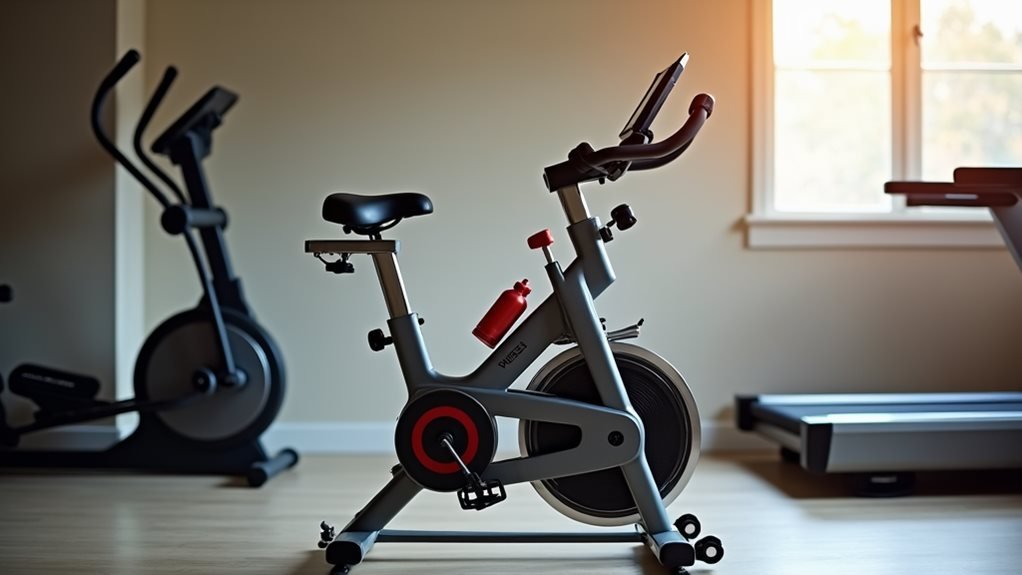
When choosing between exercise equipment options, it’s important to understand how upright bikes stack up against their alternatives. I’ll break down the key differences that’ll help you make an informed decision.
| Equipment Type | Key Advantage | Best For | Price Point |
|---|---|---|---|
| Upright Bikes | Full-body engagement | All-around fitness | Mid-range |
| Recumbent Bikes | Joint comfort | Recovery/seniors | Mid to high |
| Smart Bikes | Interactive features | Tech-savvy users | Premium |
| Indoor Cycles | Simple design | Budget-conscious | Budget |
Let me be clear: upright bikes hit the sweet spot between functionality and value. While recumbent bikes excel for those with back issues, they won’t give you the same core workout. Smart bikes like the NordicTrack S22i pack impressive features but demand subscription fees. Indoor cycling bikes? They’re budget-friendly but often lack the precision of magnetic resistance systems.
I’ve found upright bikes offer the most versatile workout experience. You’ll get digital resistance control, pre-set programs, and the ability to stand while pedaling – features you won’t find on basic stationary bikes. Plus, you’re not locked into expensive subscriptions like with smart bikes.
Performance And Training Options
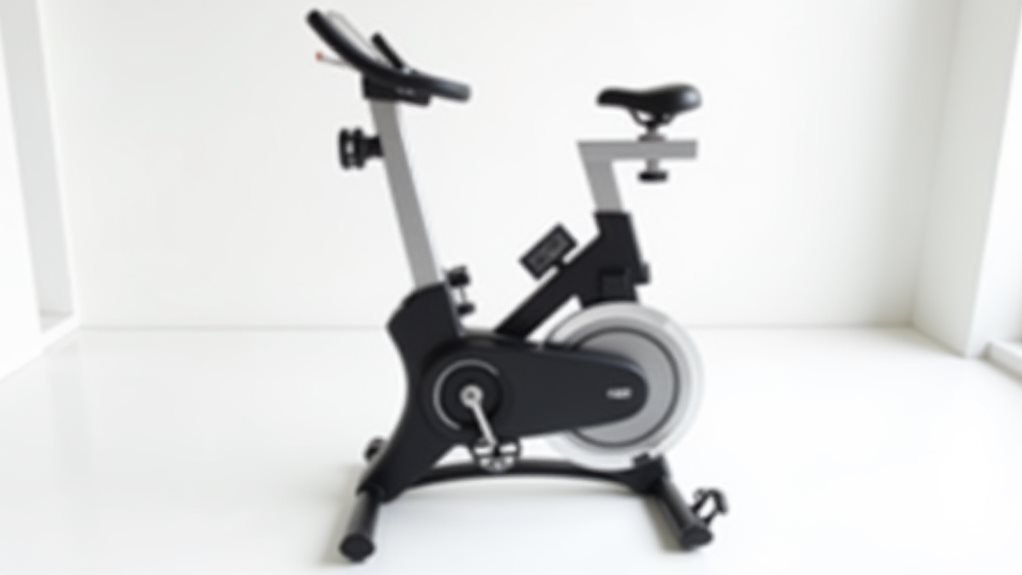
Performance versatility sets upright bikes apart when it comes to training options. I’m talking about serious customization potential here – from threshold training that pushes your aerobic limits to pyramid programs that simulate real-world terrain. You’ll find digital resistance systems offering up to 24 levels of intensity, perfect for precisely dialing in your workout.
Let me break down the key training approaches you can leverage:
- Threshold Programs: Maximize your aerobic capacity while building speed and endurance
- Heart Rate Training: Target specific zones for topnotch cardiovascular development
- Interval Sessions: Alternate between intensities to shock your system into adaptation
- Watt-Controlled Workouts: Set exact power outputs for measurable progress
I’ve seen these features revolutionize training routines. The touchscreen consoles and digital ecosystems aren’t just fancy add-ons – they’re powerful tools for tracking your metrics and progression. Trust me, whether you’re doing high-cadence sprints or endurance-focused sessions, the built-in performance options will keep you challenged.
With features like WattRate power meters and adjustable components, you’re getting a professional-grade training experience that adapts to your evolving fitness needs.
Frequently Asked Questions
How Long Do Upright Bike Seats Typically Last Before Needing Replacement?
I’ve found that bike seats typically last 400-600 hours of riding before needing replacement. You’ll notice comfort declining around 400 hours, with significant deterioration after 600 hours of use.
Can Upright Bikes Be Used Effectively While Watching Television?
I find upright bikes work perfectly while watching TV – pedal, pace, and perform. You’ll stay engaged with your show while getting a solid low-impact workout that burns calories and builds strength.
What’s the Average Noise Level of an Upright Bike During Use?
I’d say upright bikes are very quiet, typically producing around 50-60 decibels – similar to normal conversation. With magnetic resistance, you’ll barely hear anything beyond a soft whirring sound.
Do Upright Bikes Require Regular Maintenance, and What Kind?
I’d say 90% of upright bike issues are preventable with maintenance. You’ll need daily wipe-downs, weekly part checks, and monthly deep cleans to keep your bike running smoothly.
Can Multiple People of Different Heights Share the Same Upright Bike?
I can verify that multiple people can share an upright bike, thanks to quick-adjust seats and handlebars. You’ll just need to make sure the frame size accommodates everyone’s height range.
